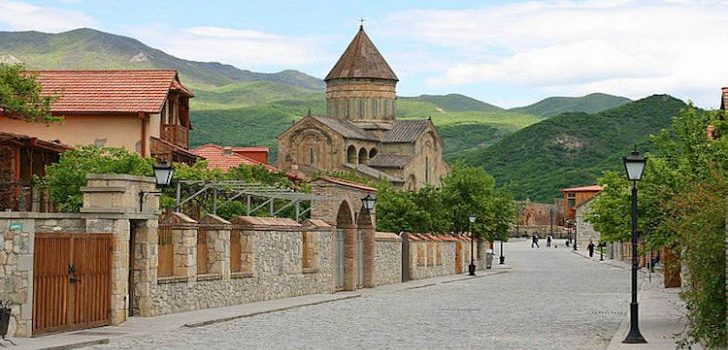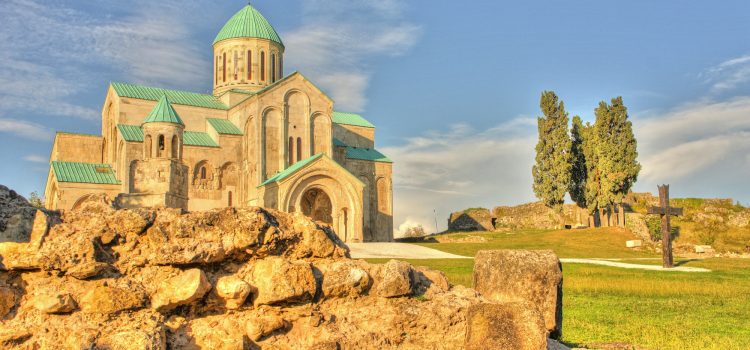Heritage Sites
Heritage Site
Cave Towns Among the few notable cave towns in the world, the Georgian ones are of very special interest. Uplistsikhe, David Gareji monastery, and the world-famous cave town of Vardzia are nominated for the UNESCO World Heritage list. Uplistsikhe, ‘the fortress of the Lord’, can be dated back to the early Iron Age, and is located on a high rocky escarpment overlooking the bank of the Mtkvari River. Cut from natural sandy stone, the 8 hectares of cave-town have survived millions of people, erosion, aging and even earthquakes, but it still remains a good example of the mixture of pagan & Christian architecture. David Gareji monastery was founded in the 6th century on the slopes of the Gareji hills by one of the thirteen Syrian Fathers, Father David (Garejeli). Those fathers were missionaries from Mesopotamia promoting and spreading Christianity, the respected founders of many monasteries and holy places around Georgia. The frescoes here are superb. Some of them date as far back as the 9th and 10th centuries. The Golden Age of Georgia is directly reflected in the incredible 11th – 13th century frescoes. The incredible cave town of Vardzia dates back to Queen Tamar’s reign, nearly a thousand years ago. Her father, King George III started the foundation of the complex, while Queen Tamar continued its construction. Many frescoes date back to the beginning of the XII century. The complex itself consists of small chapels, bell towers, secret tunnels, monks’ caves as well as a fully functioning monastery to this day. Set in the most serene and stunning countryside, its beautiful location captures your imagination and brings you back to the era of Queen Tamar’s reign. Bagrati Cathedral and Gelati Monastery(UNESCO WEB) The construction of Bagrati Cathedral, named after Bagrat III, the first king of united Georgia, started at the end of the 10th century and was completed in the early years of the 11th century. Although partly destroyed by the Turks in 1691, its ruins still lie in the centre of Kutaisi. The Gelati Monastery, whose main buildings were erected between the 12th and 17th centuries, is a well-preserved complex, with wonderful mosaics and wall paintings. The cathedral and monastery represent the flowering of medieval architecture in Georgia. Historical Monuments of Mtskheta(UNESCO WEB) The historic churches of Mtskheta, former capital of Georgia, are outstanding examples of medieval religious architecture in the Caucasus. They show the high artistic and cultural level attained by this ancient kingdom. Upper Svaneti(UNESCO WEB) Preserved by its long isolation, the Upper Svaneti region of the Caucasus is an exceptional example of mountain scenery with medieval-type villages and tower-houses. The village of Chazhashi still has more than 200 of these very unusual houses, which were used both as dwellings and as defence posts against the invaders who plagued the region.
Bagrati Cathedral: a landmark of Georgian architecture
In this episode of ‘Postcards’, we discover Bagrati Cathedral, the symbol of the city of Kutaisi, nearly 250 kilometres west of Tbilisi.
It was built under the first Kingdom of Georgia, a period of political and economic strength for the country.
“The cathedral is one of the main tourist attractions of the city,” said ‘Postcards’ reporter Claudio Rosmino.
“It is named after King Bagrat III, who commissioned its construction in the early years of the 11th century. Since then, it has become a landmark of Georgian architecture.”
The cathedral suffered heavy damage throughout the centuries and was gradually renovated from 1952 to 2012.
“Bagrati Cathedral is in a 3,500-year-old city, one of the oldest in the world,” explained Sulkhan Kuprashvili, a professor of history from Kutaisi State University.
“The construction of this church started a golden age for Georgia. For centuries, Bagrati has remained a symbol of the country with its high standards of education and culture.”
Bagrati Cathedral is now of only limited use for services of worship.
Source: Euronews.com


